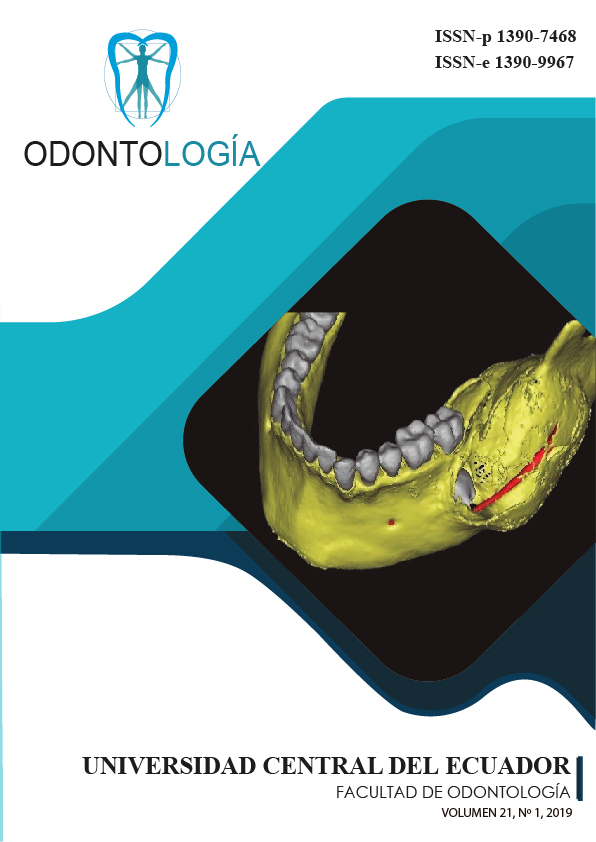Effectiveness of intraoral and extraoral polishing systems for ceramic surfaces: In vitro comparative study
DOI:
https://doi.org/10.29166/odontologia.vol21.n1.2019-26-33Abstract
The correct adjustment and polishing of dental ceramic restorations is essential to preserve the durability and structural integrity of the ceramic material and its antagonist. Objective: To determine the effectiveness of the intraoral and extraoral polishing systems for ceramics. Materials and Methods: 40 samples of feldspathic porcelain (Denstply, Ceramco III) were made in the form of a disk (7mm in diameter and 3mm in thickness), subsequently all samples were glazed and four groups were randomly formed: G1 Positive Control ( Glazed porcelain), G2 abrasion with diamond burs and extraoral polishing system (Masterdent), G3 abrasion with diamond burs and intraoral polishing system (Jota), G4 abrasion with diamond burs and intraoral polishing system (RA-KIT) The roughness of the abrasive and polished surfaces was evaluated by means of a digital roughness meter (TESTER SRT-6200 roughness pattern Ra 1.64um, velocity 0.1135 mm/s wavelength 0.25mm). The statistical analysis was through the ANOVA and Tukey tests with a significance level of 5%. Results: Anova showed significant differences in all groups (p <0.05). Tukey identified that there is no significant difference between groups G1 and G3 (p> 0.05), while for groups G2 and G4 there were statistically significant differences (p <0.05) with respect to G1. Conclusion: The G3 intraoral polishing system (JOTA) showed greater effectiveness and no significant difference respect to the control group.
Downloads
References
Arana B, Sepulveda W, Buitrago S, Oviyuzz J, Panesso S. Evaluación in vitro de la rugosidad de un sistema de cerámica comparando cuatro diferentes técnicas de pulido. Rev. Cient. Odontol. 2014;10(1): 23-5.
Lopez M, Flores P. Estudio comparativo in vitro de pulido de porcelana feldespatica usando instrumentos intraorales y pastas diamantadas. Odontoinvestiogacion, 2015: 14-21.
Sarikaya I, Guller A. Effetcs of different polishing techniques on the Surface roughness of dental porcelains. J Appl Oral Sci. 2010;18(1):10-6.
Rocha D, Travassos A, Pagani C, Torres C, Teixeira S. Evaluación in vitro de la influencia de sistemas de pulimento intra-oral en la rugosidad superficial de una cerámica odontológica después del ajuste. Acta Odontológica Venezolana. 2011; 49 (3): 1-8.
González A, Virgilio T, de la Fuente J, García R. Tiempo de vida de las restauraciones dentales libres de metal: revisión sistemática. Revista ADM 2016; 73 (3): 116-20.
Álvarez MA, Peña JM, González IR, Olay MS. Características generales y propiedades de las cerámicas sin metal. RCOE, 2003; 8(5): 525-546.
Manoj S, Raghavendra J, Prasad K. The Effects of Porcelain Finishing and Polishing Systems on the Surface Roughness of feldspathic porcelain: an In Vitro Study. Department of Prosthodontics and Crown and Bridge, Attavar Balakrishna Shetty Memorial Institute of Dental Sciences, Nitte University. 2016; 3(4):158-162.
Hatrick C. Eakle S. Bird W. Materiales dentales aplicaciones clínicas. Colombia: Editorial El Manual Moderno; 2012
Anusavice, Kenneth J. Phillips ciencia de los materiales dentales. Undécima edición. Madrid. Editorial ELSEVIER. 2004
Cova J. Biomateriales Dentales. Segunda edición. Venezuela. Editorial Amolca. 2010.
Rashid H. The effects of Surface roughness on ceramics used in dentistry: A review of literatura. Eur J Dent 2014; 8:571-9.
Oliveira O, Buso L, Horoshi F, Leao G, Campos F, Ramalho H, Assuncao R. Influrnce of polishing procedures on the Surface roughness of dental ceramics made by different techniques. General dentistry. January 2013.
Balarezo A, Taipe C. Sistema In-Ceram® y sistema Procera®. RevEstomatol Herediana. 2006; 16 (2): 131 - 138.
Martinez F, Pradies G, Saurez M, Rivera B. cerámicas dentales: clasificación y criterios de selección. RCOE, 2007;12(4): 253-263.
Haralur SB. Evaluation of efficiency of manual polishing over autoglazed and overglazed porcelain and its effect on plaque acumulation. J AdvProsthodont. 2012; 4(4):179-186.
Han GJ, Kim JH, Lee MA, Chae SY, Lee YH, Cho BH. Performance of a novel polishing rubber wheel in improving surface roughness of feldspathic porcelain. Dent Mater J. 2014; 33(6): 739–48.
Sadaqah NR. Ceramic laminate veneers: materials advances and selection. Open Journal of Stomatology. 2014; 4: 268-279.
Owen S, Reaney D, Newsome P. Finishing and polishing porcelain surfaces chairside. Int Dent J. Australasian Edition 2011;6(4):68-73.
Durães I, Lennon G, Fernandez C, Barreto V O, Castor E. Effects of different polishing systems on the surface roughness of two ceromers. Brazilian Dental Science. 2016; 19(2).
Atala, Mustafa Hayati, and EsmaBasak Gul. How to Strengthen Dental Ceramics. International Journal of Dental Sciences and Research 3.2 (2015): 24-27.
Flury S. Lussi A. Performance of Different Polishing Techniques for Direct CAD/CAM Ceramic Restorations. Article in Operative Dentistry 2010;35(4):470-81
Cherry Anmol, Sumeet Soni. Effect of two different finishing systems on surface
roughness of feldspathic and fluorapatite porcelains in ceramo-metal restorations: Comparative in vitro study. J Int Soc Prev Community Dent. 2014; 4(1): 22–28.
Sumit Sethi, Dilip Kakade, Shantanu Jambhekar, Vinay Jain. An in vitro investigation to compare the surface roughness of auto glazed, reglazed and chairside polished surfaces of Ivoclar and Vita feldspathic porcelain. J Indian Prosthodont Soc. 2013; 13(4): 478–485.
Ccahuana Vásquez VZ, Morais AALO, Nishioka RS, Kimpara ET. Estudio comparativo de la rugosidad superficial en cerámicas de ultra baja fusión. Rev Estomatol Herediana. 2007; 16(1):11-15.
Tuncdemir A, Dilber E, Kara H, Nilgun A. The Effects of Porcelain Polishing Technique son the Color and Surface Texture of Different Porcelain Systems. Materials Sciences and Applications, 2012, 3, 294-300.
Steiner R, Beier US, Heiss-Kisielewsky, Engelmeier R, Dumfahrt H, Dhima M. Adjusting dental ceramics: An in vitro evaluation of the ability of various ceramic polishing kits to mimic glazed dental ceramic surface. J. Prosthet Dent. 2015. Vol 113 Issue 6. Pág: 616-622.


